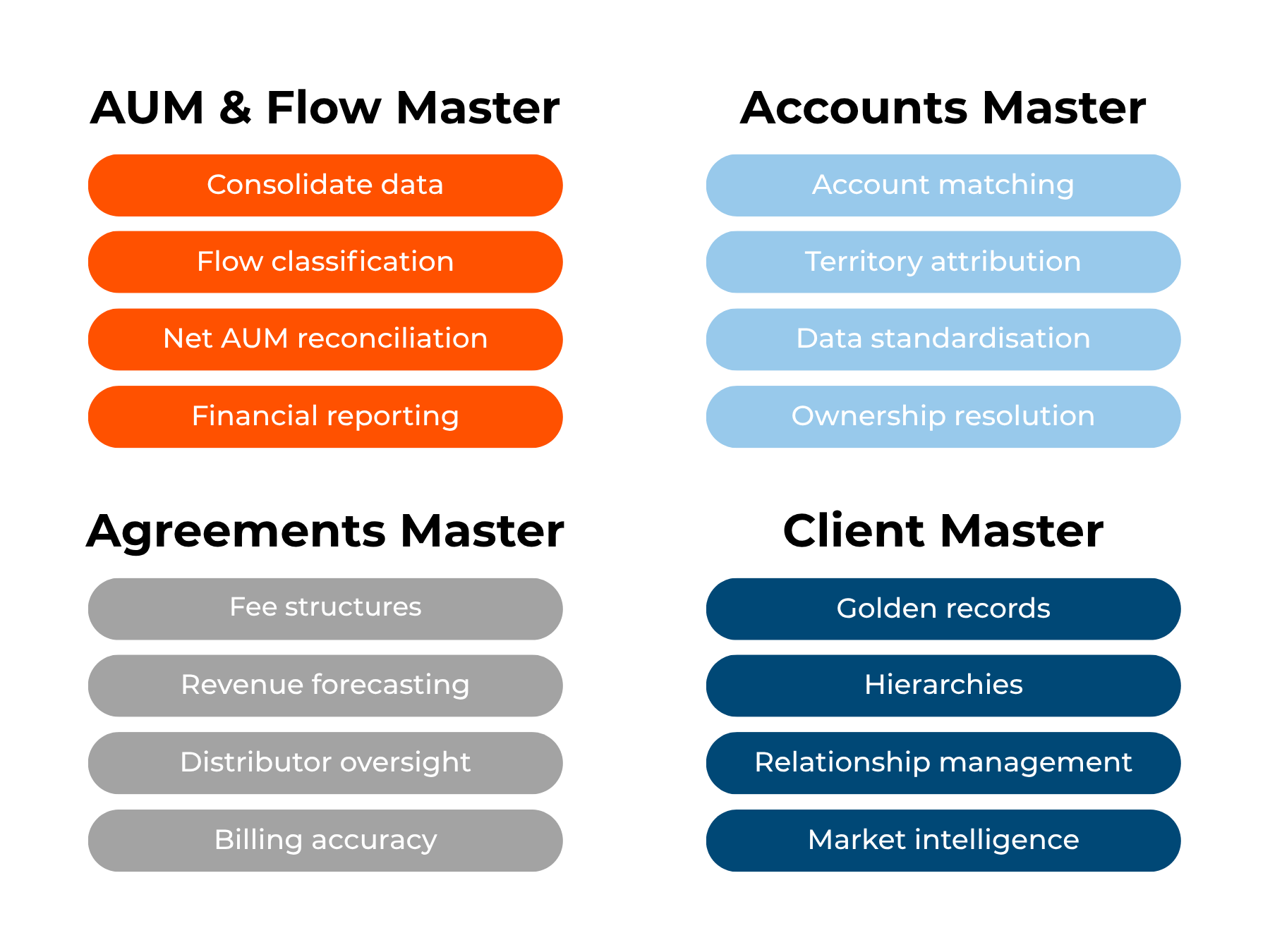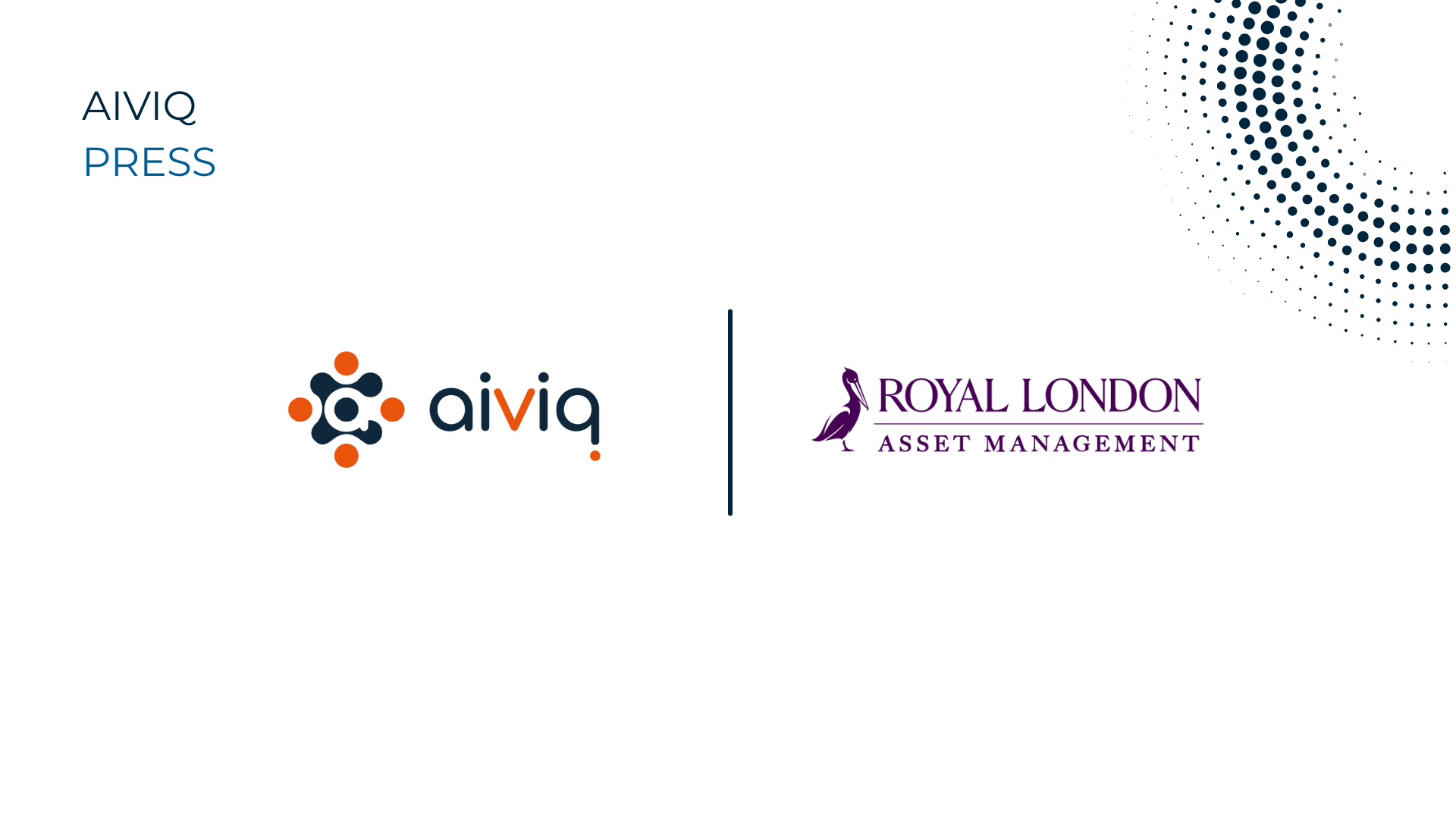In an industry managing $130 trillion in assets globally (Aiviq, 2025), asset managers face a critical challenge: fragmented client data scattered across hundreds of sources, creating operational inefficiencies that cost the industry an estimated $1 billion annually. Master data management (MDM) has emerged as the essential foundation for modern asset management operations, transforming how firms manage client relationships, report financials, and make strategic decisions. But this time it's different - AI has fundamentally changed the equation. The opportunity to reduce costs and improve quality at scale with fewer people is now more real than ever.
The $1 Billion Client Data Problem
The global investment management landscape presents unprecedented complexity. With millions of client relationships spanning multiple vehicles, markets, and distribution channels, asset managers grapple with inherent challenges that directly impact their bottom line:
Data fragmentation across the distribution chain. Client information arrives through hundreds of potential data sources - fund accountants, transfer agents, platforms, custodians, and distributors - each with different formats, frequencies, and levels of completeness. This lack of industry standardisation creates overlapping, often conflicting views of the same client across the distribution chain.
Operational inefficiencies that drain resources. Manual processes dominate client data management, creating major key person dependencies and vulnerability. Finance teams spend weeks consolidating monthly reports. Distribution operations manually match accounts to clients. Sales representatives lack real-time visibility into client holdings across products.
For a typical large asset manager, Aiviq analysis has found that these challenges translate into quantifiable costs: approximately $585,000 in inefficient reporting, $300,000 in technology and data upkeep, $800,000 in revenue leakage, $250,000 in growth constraints, and $300,000 in compliance and oversight costs annually.

What Is Master Data Management for Asset Managers?
Master data management is the discipline of creating and maintaining a single, authoritative source of truth for critical business entities. In asset management, this centers on what's known as the Client Book of Record (CBOR) - a complete, trusted view of client economics across all vehicles and markets.
Effective master data management for asset managers encompasses core data masters such as:
AUM & Flow Master consolidates assets under management and client flow data from hundreds of global sources into a unified, version-controlled dataset. This enables firms to report firm-wide financials in hours rather than weeks, with advanced rules ensuring data completeness and accuracy across fund accountants, transfer agents, platforms, and custodians.
Accounts Master standardises data across multiple transfer agents using AI-powered enrichment to resolve one of the most time-consuming challenges in client data management: understanding who actually owns each account when names are inconsistent, incomplete, or structured differently across administrators. Sophisticated algorithms automate the complex process of matching accounts to client entities and a flexible rules engine enabling sales territory attribution with granular criteria options while maintaining user control over the assignment process.
Agreements Master centralises oversight of all distributor relationships, legal entities, and commercial terms. By mastering institutional and intermediary fee arrangements - from flat fees to complex tiered structures - firms gain daily annualised net revenue insights that drive accurate forecasting and prevent costly billing errors.
Client Master creates golden records for all client entities, managing complex organisational hierarchies and commercial relationships, down to the contact level. This enterprise master extends across your full spectrum of relationships - from direct invested clients and prospects to indirect clients and trading platform intermediaries. When integrated with third-party market data, this becomes a powerful tool for sales and marketing teams to drive coordinated prospecting and informed client servicing.

How Master Data Management Transforms Asset Management Operations
Eliminating Operational Risk Through Centralised Data Governance
Operational risk in asset management often stems from data quality issues, manual errors, and lack of oversight across the distribution value chain. Master data management addresses these risks through:
Centralised validation and stewardship workflows ensure data accuracy before it propagates through downstream systems. When new client accounts are onboarded, automated validation rules check for completeness, flag anomalies, and route exceptions to the appropriate stewards for resolution.
Automated reconciliation across data sources identifies discrepancies between internal books and records (IBOR/ABOR) and client books of record. This includes reconciling product cross-holdings, performing omnibus look-through calculations, and distinguishing genuine client flows from market movements - complex tasks that previously required significant manual effort.
Real-time anomaly detection monitors thousands of daily data files using AI-powered intelligence, identifying processing issues before they impact financial reporting or client servicing. When a transfer agent file arrives with missing positions or a distributor feed shows unexpected AUM movements, the system alerts appropriate teams with context for rapid remediation.
For asset managers, this translates to reduced operational errors, faster issue resolution, and significantly lower regulatory and reputational risk.
The Critical Role of MDM in AUM Reporting and Financial Close
Perhaps nowhere is the impact of master data management more immediately visible than in the monthly financial close process. Traditional approaches require finance teams to spend days or weeks consolidating data from disparate sources, manually adjusting for known issues, and reconciling discrepancies between systems.
A robust AUM & Flow Master changes this paradigm entirely. By consolidating data from 300+ global sources into a unified model, applying sophisticated financial enrichment rules, and auto-reconciling complex scenarios, firms can report firm-wide financials in hours rather than weeks.
Consider the complexity involved: AUM inference and roll-forward calculations, product matching across different naming conventions, FX conversions accounting for holidays and market closures, flow classification distinguishing client activity from market movements, and net AUM reconciliation that looks through omnibus structures and product cross-holdings.
Advanced master data management platforms handle these calculations through configurable rules engines whilst maintaining full audit trails. The system processes millions of transactions with incremental processing capabilities, supports period locking for regulatory compliance, enables temporal reporting for point-in-time analysis, and facilitates historical restatements when methodologies change.
Master Data Management and Regulatory Compliance
Regulatory requirements across global markets demand increasing transparency into client relationships, fee arrangements, and beneficial ownership. Master data management provides the foundation for meeting these obligations efficiently:
Complete audit trails track every change to client records, account attributions, and financial terms over time. When regulators request evidence of due diligence or fee disclosure, firms can produce comprehensive documentation instantly rather than reconstructing information from emails and spreadsheets.
Distributor and intermediary oversight centralises monitoring of the entire distribution value chain, ensuring firms maintain current knowledge of their business relationships. This proves critical for AML/KYC obligations, conflicts of interest disclosure, and distribution oversight requirements that vary by jurisdiction.
Fee and rebate accuracy prevents regulatory scrutiny arising from billing errors or undisclosed arrangements. By mastering all financial terms in a single system with automated calculation and validation, firms ensure compliance with fee disclosure requirements whilst avoiding costly errors that trigger client complaints or regulatory investigations.
Leading asset managers recognise that robust master data management isn't merely a compliance checkbox - it's a strategic capability that reduces regulatory risk whilst improving operational efficiency.





